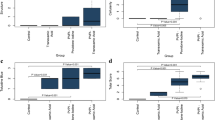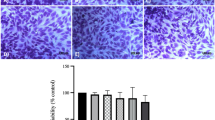Abstract
The objective of this study was to investigate the toxic effects of povidone–iodine (PVI). A series of MTT assay of cultured synovial cells stimulated by PVI have been made. Test for assay of membrane-toxic effect of PVI and lactate dehydrogenase (LDH) has also been carried out. After making intraarticular injection into rats’ hind knee joints with 0.1 ml of PVI every day for 1 week, we have extracted the knee joints and blood from rats in four divided groups on the 0, 1st, 3rd, and 7th day. Our microscopic analysis was performed that cartilage and synovium membrane were stained with hematoxylin, toluidine blue, and safranin O. Iodine, glutamic oxaloacetic transminase, creatine phosphokinase (CPK), and LDH in rat sera have been measured. We were able to confirm cytotoxicity in the synovial cells placed in PVI concentration of more than 6.25×10−2%. In comparison with the positive control, LDH, in this case, was released at the concentration level of 33.3%. Independent of period of stimulation, LDH was released the most in the PVI concentration of 6.25×10−2. The histopathological analysis of articular cartilage has indicated clear morphological alterations in rats’ synovium; especially, toluidine blue staining and safranin O staining were seen in the metachromasia of articular cartilage. However, no fissures or erosive changes in the articular cartilage, which were usually observable in the case of osteoarthritis, were observed. In the synovium inflammatory cells, which were mainly plasma cells and lymphoid cells, no neutrophils were infiltrated. The degree of infiltration has increased steadily day by day. Fibrin deposition has been observed even in the synovium of 1-day stimulation. On the 7th day, a serum total iodine concentration has been 544 μg/dl, 4,440 IU/ml for CPK concentration, and 2,049 IU/ml for LDH concentration, while the control concentrations have been 7.1 μg/dl, 491 IU/ml, and 700 IU/ml, respectively. Our experiment has disclosed that PVI preparation is strongly cytotoxic to synovial cell and articular cartilage.








Similar content being viewed by others
References
Fukasawa N, Shirakura K (1997) Candida arthritis after total arthroplasty—a case of successful treatment without prosthesis removal. Acta Orthop Scand 68:306–307
Molina ME, Nonweiller DE, Evans JA (2000) Contaminated anterior cruciate ligament graft: the efficacy of 3 sterilization agents. J Arthroscopy 16:373–378
Ritter AR, Campbell ED (1988) Retrospective evaluation of an iodophor-incorporated antimicrobial plastic adhesive wound drape. Clin Orthop 228:307–308
D’auria J, Lipson S, Garfield JM (1990) Fatal iodine toxicity following surgical debridement of a hip wound: case report. J Trauma 30:353–355
Kaysinger KK, Nicholson NC, Ramp WK (1995) Toxic effects of wound irrigation solutions on cultured tibiae and osteoblasts. J Orthop Trauma 9:303–311
Kramer SA (1999) Effect of povidone–iodine on wound healing: a review. J Vasc Nurs 17:17–23
Naumann A, Dennis JE, Awadallah A (2002) Immunochemical and mechanical characterization of cartilage subtypes in rabbit. J Histochem Cytochem 50:1049–1058
Berkelman RL, Holland BW, Anderson RL (1982) Increased bactericidal activity of dilute preparations of povidone–iodine solutions. J Clin Microbiol 15:635–639
Rackur H (1985) New aspects of mechanism of action povidone–iodine. J Hosp Infect 6:13–23
Zamora JL (1986) Chemical and microbiologic characteristics and toxicity of povidone–iodine solutions. Am J Surg 151:400–406
Wutzler P, Sauerbrei A (2002) Virucidal activity and cytotoxicity of the liposomal formulation of povidone–iodine. Antivir Res 54:89–97
Blain AK, Pratt L (2002) Dilute povidone–iodine solutions inhibit human skin fibroblast growth. Dermatol Surg 28:210–214
Kwaan JHK, Connolly JE (1981) Successful management of prosthetic graft infection with continuous povidone–iodine irrigation. Arch Surg 116:716–720
Faddis D, Daniel D, Boyer J (1977) Tissue toxicity of antiseptic solutions. A study of rabbit articular and periarticular tissues. J Trauma 17:895–897
Wilken R, Botha SJ, Grobler A (2001) In vitro cytotoxicity of chlorhexidine gluconate, benzydamine–HCl and povidone iodine mouthrinses on human gingival fibroblasts. S Afr Dent J 56:455–460
Aizawa K, Yoshida M, Shiba K (2001) Microbiological evaluation of disinfectants by microplate method and clinical study. Chemotherapy 49:36–44
Author information
Authors and Affiliations
Corresponding author
Rights and permissions
About this article
Cite this article
Kataoka, M., Tsumura, H., Kaku, N. et al. Toxic effects of povidone–iodine on synovial cell and articular cartilage. Clin Rheumatol 25, 632–638 (2006). https://doi.org/10.1007/s10067-005-0133-x
Received:
Revised:
Accepted:
Published:
Issue Date:
DOI: https://doi.org/10.1007/s10067-005-0133-x




